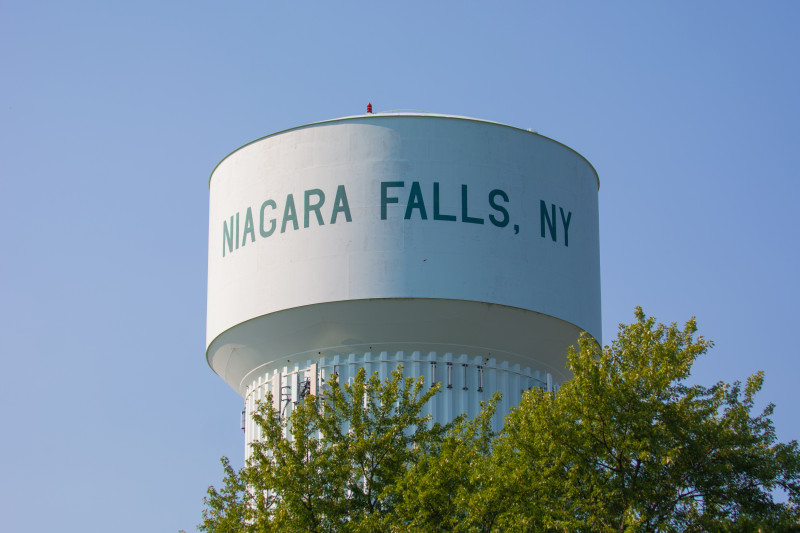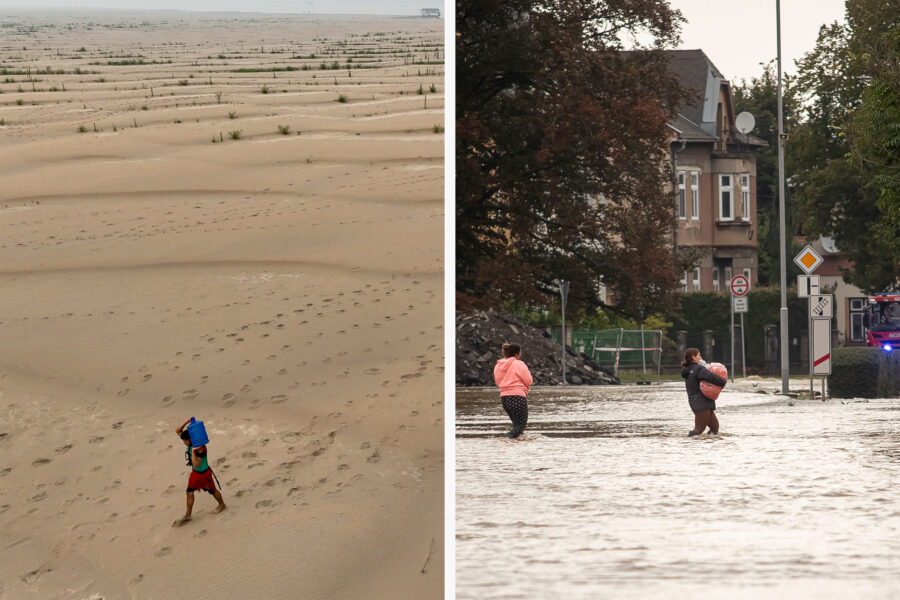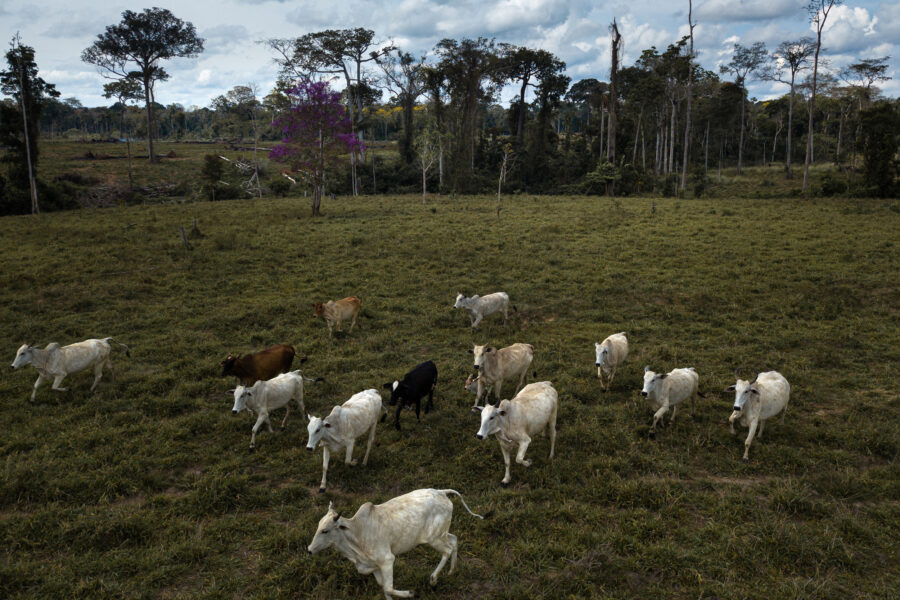A Dangerous Chemical Is Fouling Niagara Falls’ Air. New York State Hasn’t Put a Stop to It
This story is a collaboration between Public Health Watch, WBFO and Inside Climate News.
For at least 15 years, a Goodyear Tire & Rubber Co. chemical plant in Niagara Falls, New York, has been sending a pollutant that causes bladder cancer into the air at levels 1,000 percent higher than what state regulators now consider safe for the public to breathe, documents show.
The New York State Department of Environmental Conservation (DEC) issued a notice of violation to Goodyear in July 2023 for failing to control emissions of the bladder carcinogen, ortho-toluidine, and another pollutant, diphenylamine, known as DPA. But more than a year later, the DEC still hasn’t ordered the company to reduce those emissions, even though the agency severely tightened the airborne limit for ortho-toluidine in 2021 due to the chemical’s potent cancer-causing properties.
The DEC violation notice focuses on two pollution-control devices that have failed to adequately capture ortho-toluidine and DPA. Ortho-toluidine is a known human carcinogen that was linked to bladder cancer in animal experiments as far back as the 1950s. DPA is a possible carcinogen that may damage the bladder, kidneys and liver. According to the plant’s state-issued 2009 permit, both are considered “A-rated” air toxics by the DEC, referring to a substance whose “discharge results, or may result, in serious adverse effects on individuals or the environment.”
Explore the latest news about what’s at stake for the climate during this election season.
In a statement, a DEC spokesman wrote, “Protecting New York’s air quality, and the health of our communities, is a top priority for DEC and DEC will continue to take the appropriate actions involving the Goodyear Chemical facility in Niagara Falls to ensure compliance with applicable air emission standards and the protection of public health and the environment. … DEC’s investigation continues, which includes communications with the company regarding potential facility modifications.“
Goodyear said in a statement that the company’s Niagara Falls plant “is subject to air permit requirements that are based on the state’s prior [limit] for ortho-toluidine, and Goodyear is in compliance with those permit requirements.”
The Niagara Falls plant, which has used ortho-toluidine since 1957 to make an additive that keeps tires from cracking and generates DPA as a byproduct, is the site of one of the nation’s worst occupational outbreaks of bladder cancer. The disease ensnared plant workers at a rate four times higher than what would have been expected in the general public, federal health investigators found. They deemed exposure to ortho-toluidine to be the likely cause. At least 78 Goodyear workers have developed bladder cancer since the mid-1980s.
The previously undisclosed DEC documents—obtained through open-records requests and provided to Public Health Watch, WBFO and Inside Climate News—suggest that people who live near the Goodyear plant, about three miles east of downtown Niagara Falls, are also at risk.
“It was incumbent on the state and the company to inform the people downwind that this was going on,” said retired lawyer Steven Wodka, who over more than three decades represented 29 Goodyear workers with bladder cancer in litigation against chemical suppliers. “To my knowledge, that hasn’t happened. I’m greatly concerned that the people who live around the plant have no idea what they are potentially being exposed to.”
The DEC spokesman did not respond when asked if the community had been notified of Goodyear’s emissions.
Cancer Could Cost Niagara County
Bladder cancer “is one of the most challenging and expensive cancers to diagnose and treat,” according to the International Agency for Research on Cancer. Niagara County has one of the highest incidence rates of bladder cancer in the state—and the nation.
The county, according to National Cancer Institute data for 2017-2021, has an age-adjusted rate of 31.9 cases per 100,000 people. The average for the state as a whole is 20.8 cases per 100,000.
Niagara County’s bladder cancer rate is also significantly higher than the U.S. average of 18.8 cases per 100,000. The county ranks 21st nationally.
A study in Cancer Epidemiology, Biomarkers & Prevention predicts that population aging and growth will increase the national cost of medical care for bladder cancer by 45% from 2015 to 2030. But cancer doesn’t just tax the health care system—it taxes communities and their resources.
“It's horrific,” Todd Vaarwerk, chief policy officer for Western New York Independent Living, said when he was told of the Goodyear emissions. Independent Living Centers advocate for and provide support to disabled people in their communities. “We don’t need anybody trying to increase the population of people needing independent living services.”
People who develop cancer not only face the cost of treatment, Vaarwerk said; they also face the cost of added support.
“It isn’t just a thing about, you’re going to the doctor more often,” he said. “Aide service, wheelchairs, durable medical equipment, all of that stuff is more costly, right?”
Exposure to carcinogens can have a ripple effect. The patient may require state assistance to help pay for medical care and other services, like home care. The community winds up footing the bill for an illness that may have been preventable.

According to U.S. Census estimates, within the ZIP code 14304—which includes the Goodyear plant and neighborhoods to the east of it, including the infamously contaminated Love Canal subdivision—15.4% of the population already identifies as having some form of disability. This is slightly higher than the national average estimate of 13.6%.
“We really don't need a company kind of adding to the group of people that we're serving,” Vaarwerk said. “We are highly concerned both about the existence of this problem and DEC kind of not closing the barn door to remediate the problem, to make sure it doesn't get worse.”
Love Canal’s Legacy
Two former residents of Love Canal—an emblem of America’s toxic-waste crisis in the late 1970s that inspired Congress to create the Superfund waste-cleanup program—said they were unaware of the ongoing pollution from Goodyear and were dismayed that the DEC had not moved to stop it.
“I’m baffled by how it just keeps on keeping on,” said Lois Gibbs, who became the reluctant face of the Love Canal tragedy. She and her first husband, Harry, lived in the neighborhood and Harry worked at the Goodyear plant. He died of a heart attack at 36. “Nothing changes in Niagara Falls. Nothing changes at the DEC,” Gibbs said.
Gibbs recalled that emissions from Goodyear’s stacks used to fall on workers’ vehicles in the plant parking lot and dissolve the paint. The company regularly paid to have the vehicles repainted, she said.

For decades after World War II, Niagara Falls was a chemical-manufacturing leviathan, home to plants run on cheap hydroelectric power by companies including DuPont, Union Carbide and Occidental. Beginning in the 1970s, it went into steep decline as plants closed and once-plentiful jobs disappeared. The city’s population plummeted; crime and poverty soared. Unlike its namesake across the Niagara River in Ontario, it never became a tourist mecca, despite its proximity to one of the world’s natural wonders.
Gibbs, who retired two years ago as director of the Center for Health, Environment and Justice, a nonprofit advocacy organization, said that even in its diminished state, “industry still rules” in Niagara Falls. “People of low wealth are dispensable,” she said. “It’s just not right. It is so not right.”
Love Canal was built atop a waste dump laden with dioxin and other poisons. Former resident Luella Kenny said she was “surprised that somebody hasn’t done something” about the Goodyear emissions. Kenny’s 7-year-old son Jon Allen was diagnosed with a type of kidney disease, minimal lesion nephrosis, in June 1978 and died just four months later, as the Love Canal saga was unfolding. Three days after his death, a deputy director at the state health department told the Buffalo Courier-Express “it is unusual for seven-year-old children to die.” Kenny, a retired cancer researcher, blamed high levels of dioxin in her backyard for the boy’s death, though she was unable to prove it in court.
A New Threat
The threat posed by Goodyear’s air emissions of ortho-toluidine is the latest chapter in Niagara Falls’ sordid environmental history.
In its violation notice last year, the DEC found that Goodyear had been exceeding the “annual guideline concentration” for ortho-toluidine—the concentration that can legally be released into the air each year—by “three orders of magnitude” because of the deficient pollution-control devices, known as the Tri-Mer scrubber and Elimination Tank 2.
The scrubber, installed in 1992, is supposed to capture 90 percent of the ortho-toluidine and DPA that are routed through it. Instead, tests by Goodyear showed it caught none of the DPA and only 53% of the ortho-toluidine. The elimination tank, installed in 2001, captured only 11 % of the ortho-toluidine that passed through it.
As these devices were underperforming, the state was reexamining the annual guideline concentration for ortho-toluidine. In 2021, it changed the airborne limit from 21 micrograms of ortho-toluidine per cubic meter of air to 0.02 micrograms. The change was based on the International Agency for Research on Cancer’s designation of ortho-toluidine as a known human carcinogen in 2008.
The state officially knew of the excess plant emissions no later than February 2023, when a Goodyear contractor submitted a report detailing test results. But a January 2010 email to Goodyear from Jacqueline DiPronio, then an environmental program specialist with the DEC in Buffalo, suggests the state had suspicions about the pollution-control equipment 13 years earlier, after the company submitted data of dubious quality.
“Basically, I can make no sense of the information provided and it does not appear to have involved any acceptable or approved methodology to demonstrate either emission rates or control efficiency,” DiPronio, now retired, wrote.
In its statement, the DEC said, “The concerns expressed in 2010 were addressed with DEC requirements included in the comprehensive Air State Facility permit issued on April 21, 2011.” The agency did not explain why, if DiPronio’s 2010 concerns were addressed, it was necessary to issue a notice of violation to Goodyear 13 years later.
The DEC added in its statement that Goodyear’s air permit “will also require any necessary facility modifications and emission controls. The public will have the opportunity to review and comment on a draft permit.” This is a reference to a Goodyear permit renewal application that has been pending since June 2018.
Wodka, the retired lawyer, said that cases of bladder cancer have been recorded in the neighborhood immediately east of the Goodyear plant, located at 5500 Goodyear Drive. He said he had reviewed correspondence between the company and the DEC regarding the ortho-toluidine emissions and saw no evidence that Goodyear had resisted installing better pollution controls.
“It seems like they’re waiting on [the DEC] to tell them what to do,” Wodka said. “I think it’s terrible that there is a lack of any sense of urgency by either Goodyear or the DEC to get the problem corrected.”
Jim Morris is executive director and editor-in-chief of Public Health Watch, a nonprofit investigative news organization. He is the author of “The Cancer Factory,” which chronicles an outbreak of bladder cancer at the Goodyear chemical plant in Niagara Falls, New York. Emyle Watkins is an investigative disability reporter leading the Disabilities Beat at WBFO, Buffalo’s NPR Station. Watkins has also appeared on NPR and the BBC, and they authored The Global Investigative Journalism Network’s Guide to Investigating Disability Issues.
About This Story
Perhaps you noticed: This story, like all the news we publish, is free to read. That’s because Inside Climate News is a 501c3 nonprofit organization. We do not charge a subscription fee, lock our news behind a paywall, or clutter our website with ads. We make our news on climate and the environment freely available to you and anyone who wants it.
That’s not all. We also share our news for free with scores of other media organizations around the country. Many of them can’t afford to do environmental journalism of their own. We’ve built bureaus from coast to coast to report local stories, collaborate with local newsrooms and co-publish articles so that this vital work is shared as widely as possible.
Two of us launched ICN in 2007. Six years later we earned a Pulitzer Prize for National Reporting, and now we run the oldest and largest dedicated climate newsroom in the nation. We tell the story in all its complexity. We hold polluters accountable. We expose environmental injustice. We debunk misinformation. We scrutinize solutions and inspire action.
Donations from readers like you fund every aspect of what we do. If you don’t already, will you support our ongoing work, our reporting on the biggest crisis facing our planet, and help us reach even more readers in more places?
Please take a moment to make a tax-deductible donation. Every one of them makes a difference.
Thank you,
David Sassoon
Founder and Publisher
Vernon Loeb
Executive Editor
Share this article
Disclaimer: The copyright of this article belongs to the original author. Reposting this article is solely for the purpose of information dissemination and does not constitute any investment advice. If there is any infringement, please contact us immediately. We will make corrections or deletions as necessary. Thank you.








